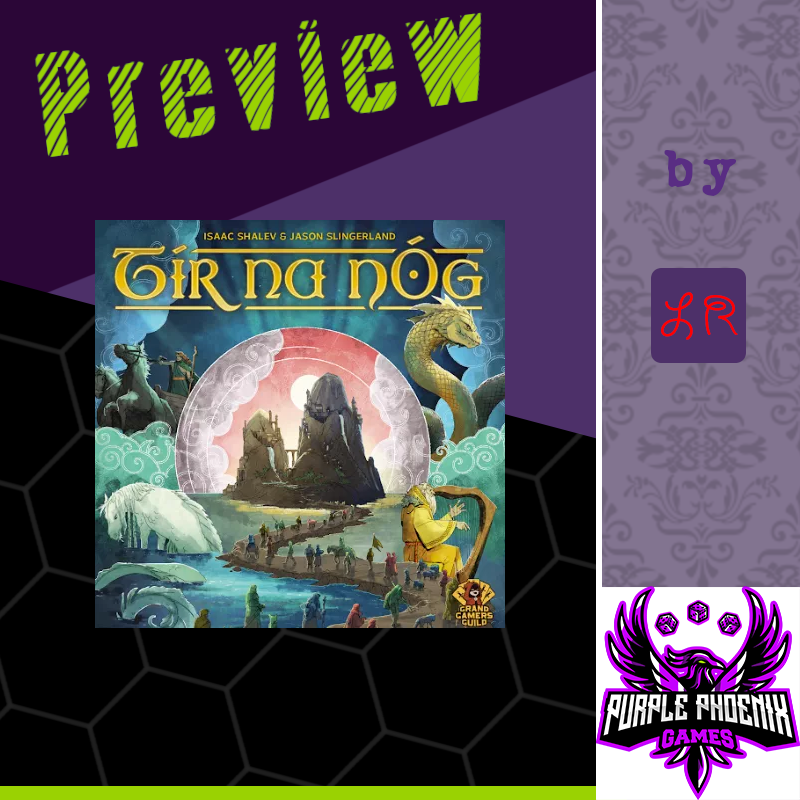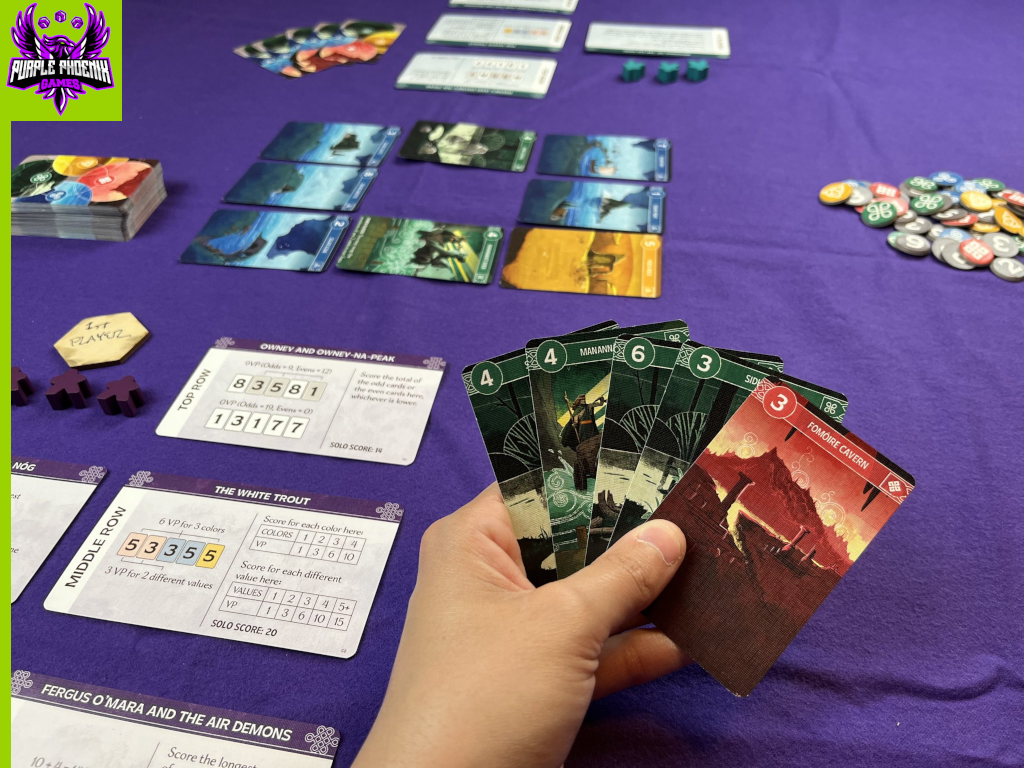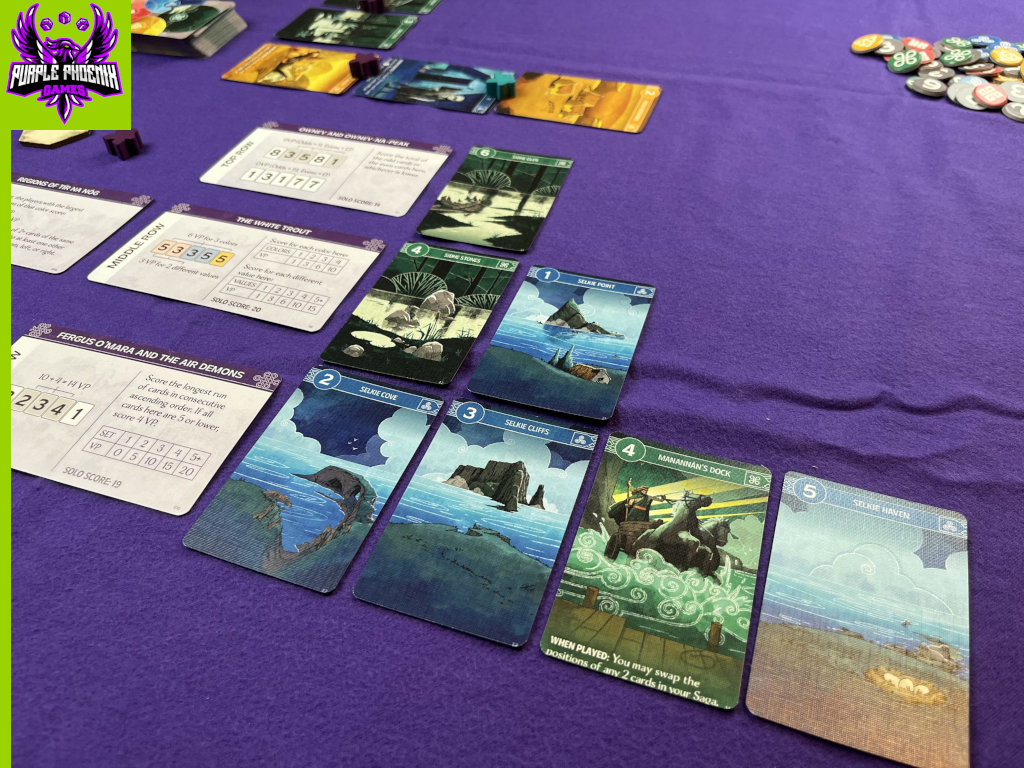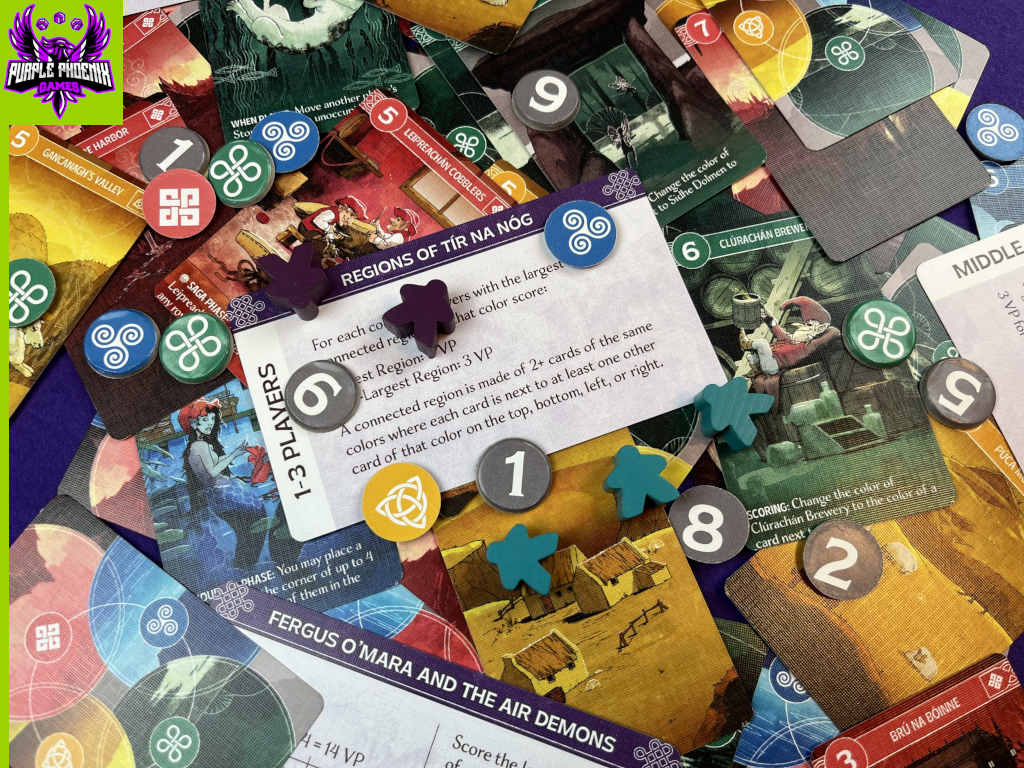
When it comes to games, there are several things that draw me in. For starters, artwork. If a game has artwork that immediately draws me in, I am sold. And obviously, theme of a game is a major element as well. So when Grand Gamers Guild reached out to me about previewing their latest game based in Irish mythology, I was instantly intrigued. After having played it now, I can say that I am hooked. And I am absolutely interested in learning more about Irish mythology in general, having gotten my toes wet with this game. Major shoutout to Grand Gamers Guild for delivering another hit that not only makes me want to play the game, but immerse myself in the theme as well. Added bonus: the campaign is still live on Gamefound, so I highly recommend you check it out before it’s too late!
| Tír na nÓg (2023) | Grand Gamers Guild |
| 1-5 players | 30-45 minutes |
| Ages 13+ | BGG Weight – 2.00 / 5 |
Disclaimer: We were provided with a prototype copy of the game for the purposes of this preview. What you see pictured may differ from the finalized production copies. -L
Tír na nÓg is a game of drafting and hand management in which players take on the roles of Celtic Storytellers who are weaving a Saga of their journeys into the Otherworld. Played over 5 rounds, players will be drafting cards and playing them to their Saga in hopes of earning the most end-game points. To setup for a game, give each player a set of Top, Middle, and Bottom Geas cards in their chosen color, as well as a Regions of Tír na nÓg card corresponding to the player count. Each player also receives 3 Storyteller tokens. Shuffle the deck of Encounter cards and deal 5 to each player. Set up a grid of Encounter cards in the center of the table to create the Otherworld, according to the player count. Select a starting player, give them the 1st Player Token, and the game is ready to begin! Setup for a 2-player game is pictured below.

The game is played over the course of 5 rounds, and each round is broken down into 3 phases: Journey, Saga, and Cleanup. During the Journey phase, players will be sending their Storytellers out to Tír na nÓg to partake in adventures to add to their Saga. Starting with the 1st Player, players will place one of their Storyteller tokens in the space between any 2 Encounter cards in the Otherworld grid, following the placement rules: Storytellers cannot occupy an already occupied space, they cannot be placed at the corners of Encounter cards, and they cannot be placed along the outer edges of the Otherworld grid. Players take turns placing 1 Storyteller at a time, until all players have placed all 3 of their Storytellers. The game then moves to the Saga phase.
In the Saga phase, played in reverse turn-order, players will be drafting Encounter cards to their hand and playing cards to their Saga. On your turn, you will first choose one of the Encounter cards that is adjacent to any of your Storyteller tokens in the Otherworld grid, and take it into your hand. Take the corresponding Storyteller from the grid and add it back to your supply. Then, select one of the Encounter cards from your hand and play it into your Saga – in either the Top, Middle, or Bottom row. Each row has placement restrictions and scoring rules on its Geas card, and will dictate which cards can be played where, so strategy is key! After drafting and playing a card, play moves to the player on your right. The Saga phase continues in this fashion until all players have resolved all of their Storytellers in the Otherworld grid.
Finally, we have the Cleanup phase. All players will discard a card from their hand, and any Encounter cards remaining in the Otherworld grid are discarded. Deal a new Otherworld grid from the draw pile, pass the 1st Player Token to the left, and start a new round. Once a total of 5 rounds have been played, move to End-Game Scoring. All players will score each row of their Saga according to their Top, Middle, and Bottom Geas cards. Players will also score the Regions of Tír na nÓg card, which will earn players points for having the largest connected region of Encounter cards in their Saga (same color Encounter cards adjacent to each other). All points are totaled, and the player with the highest score is the winner!

As you could probably tell from my introduction, I am a big fan of this game. The mechanics and gameplay themselves are pretty simple and straightforward, but the amount of strategy packed in is through the roof. For starters, each of your 3 Geas cards scores in a different way, so you’re trying to decide how best to approach your Saga to earn the maximum amount of points. The Geas cards score independently, but sometimes placements in adjacent rows can affect that scoring. So you’ve got to think of how adjacent cards can affect your Saga. Lots of the Encounter cards also have special effects that are triggered at different times throughout the game, be it once, ongoing, or during certain phases. How can you use these abilities to your advantage and boost your end-game score? Even simply playing your Storytellers to the Otherworld grid in the Journey phase is all about strategy! You need to figure out what Encounter card you need, and hope that your Storyteller placement will ensure you get that card. Or maybe an opposing Storyteller takes that card before you do – how can you work around this hindrance to salvage the Saga phase of the round? You need a strong strategy in mind when you play, but it also needs to be fairly adaptable for any un-ideal situations that may arise in a given round. You always need to be thinking several steps ahead, and that keeps me hooked into the gameplay.
Normally, I take a minute to touch on components, but seeing as this is a prototype copy of the game, I can’t really go too much into it. I can speak on the artwork though, and it’s awesome! Very thematic, the style gives me those mythology vibes, and the Celtic elements are neat. For the Storytellers, this copy just used meeples, but the customized Storytellers on the Gamefound page look awesome. Like I said, what I have here is subject to change, but it’s off to a good start already on its own.
All in all, I was pleasantly surprised by Tír na nÓg. Even though the gameplay is a little bit lighter in weight than some other Grand Gamers Guild games, it’s still super strategic! Throughout the entire game, I was engaged and thinking ahead to future turns, and that to me is a sign of a good game. I was never waiting or disengaged – I was fully immersed. Having played several times, I can tell you that it’s just as good every time you play. I like trying different strategies with every play, or even the same strategy will yield different results as the Otherworld grid and your hand of cards will never be identical from game to game. I can see this game hitting my table often, when I want something that packs a punch but doesn’t take all night to play. The campaign on Gamefound is already live, but there is still time for you to back it! Check it out – I promise you won’t be disappointed.

